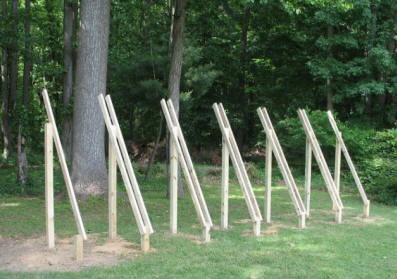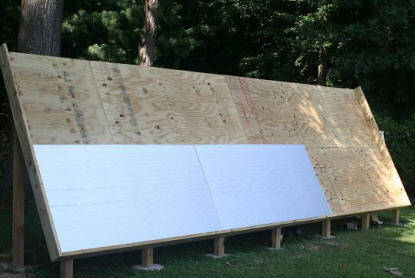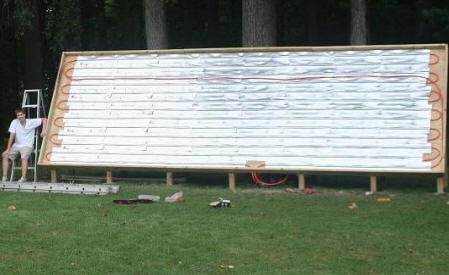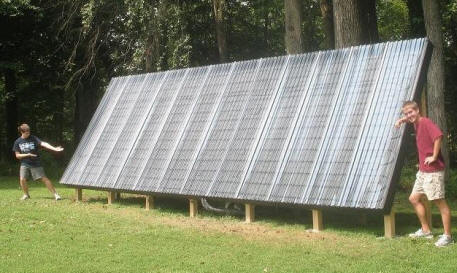
Search
The Renewable Energy site for Do-It-Yourselfers
Scott's 24 Foot By
8 Foot Solar Collector
This is a very interesting variation
on the PEX/aluminum
collector with some good ideas to consider if you are going to make a large
collector.
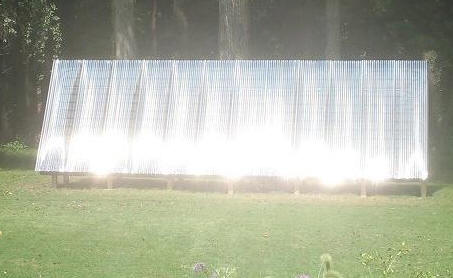
Wow!
The collector is 24 ft wide by 8 ft
high, and is built as one large single collector.
All the details are provided on Scott's site ....
Scott can also be found on the
Yahoo
Group Simply Solar -- which he founded -- its a great place to discuss
new solar thermal ideas.
Scott also
has a very nicely done Youtube video that gives a good overview of this project
and his solar air heating collector...
Some Thoughts on this Design...
I think that building the collector
as one unit like this has a lot of advantages compared to building a bunch of
separate collectors:
- It saves on materials and
results in a good solid and simple structure.
- It looks good.
- It save some time and labor.
One of the nice things about building
the collectors yourself is that you have the freedom to try things like this.
Ground mounting like this is a nice
way to go and makes the construction easier.
This same one big collector approach
can be used with the collector integrated into a building wall, as we did on the
Solar Shed... Scott's approach of
making one large, single absorber takes it a step further.
One thing that you give up with the
very wide serpentine layout of the PEX tubes is that it would not work very well
as a drain back collector. Each one of the horizontal runs in the
serpentine would need to have about 4 inches of down slope, and you would end up
losing a lot of absorber area due to the drops, but this is not an issue for the
closed loop design.
This same kind of one big collector
approach could be used with the
copper/aluminum style of collector. From a flow point of view, such a
collector could be feed at the lower left and lower right corners, with the
return from the center top. This could be done as a drain back with each
half of the collector pipe grid sloped down a little toward its return corner.
With the price of copper having come down some, this would not be much more
expensive on a dollars per BTU basis than the PEX collector.
I do have one concern. I think
that this may well be pushing the PEX too far from a temperature point of view.
The moderate tilt may result in
stagnation temperatures that are too high for the PEX and result in a short
life. Since the system is closed loop, it will be under some pressure, and
this will make life for the PEX a bit harder yet. I know that Scott is
aware that he is on the edge here and as a dyed in the wool experimenter he is
willing to take the risk of having to do some rebuilding of the absorber if the
stagnation temperatures do result in a short life. If you are less
adventurous than Scott, you may want to consider either going to the
copper/aluminum design or going to a vertical collector. Anyway, it will
be good to hear how the PEX does over the first couple seasons.
I think that Scott's design would
also work very well as a vertical collector. For space heating
applications, when you consider ground reflection, vertical collectors
perform very well -- if you have a snow field in front of the collector, a
vertical collector will do even better because it benefits from the high
reflectivity of the snow. The construction would be even simpler if the
collector were vertical. The stagnation temperatures in the summer for a
vertical collector would be much lower. As an example, at the summer
solstice, the day long radiation on a collector tilted at 65 degrees is about
1500 BTU/sqft, while a vertical collector sees only 610 BTU/sqft on the same day
-- this helps keep the stagnation temperatures down.
As you can see, I am a big fan of
vertical collectors for space heating :)
Anyway, this is a really nicely done
design and installation with lots of good ideas -- thank you Scott!
Gary October 3, 2009


